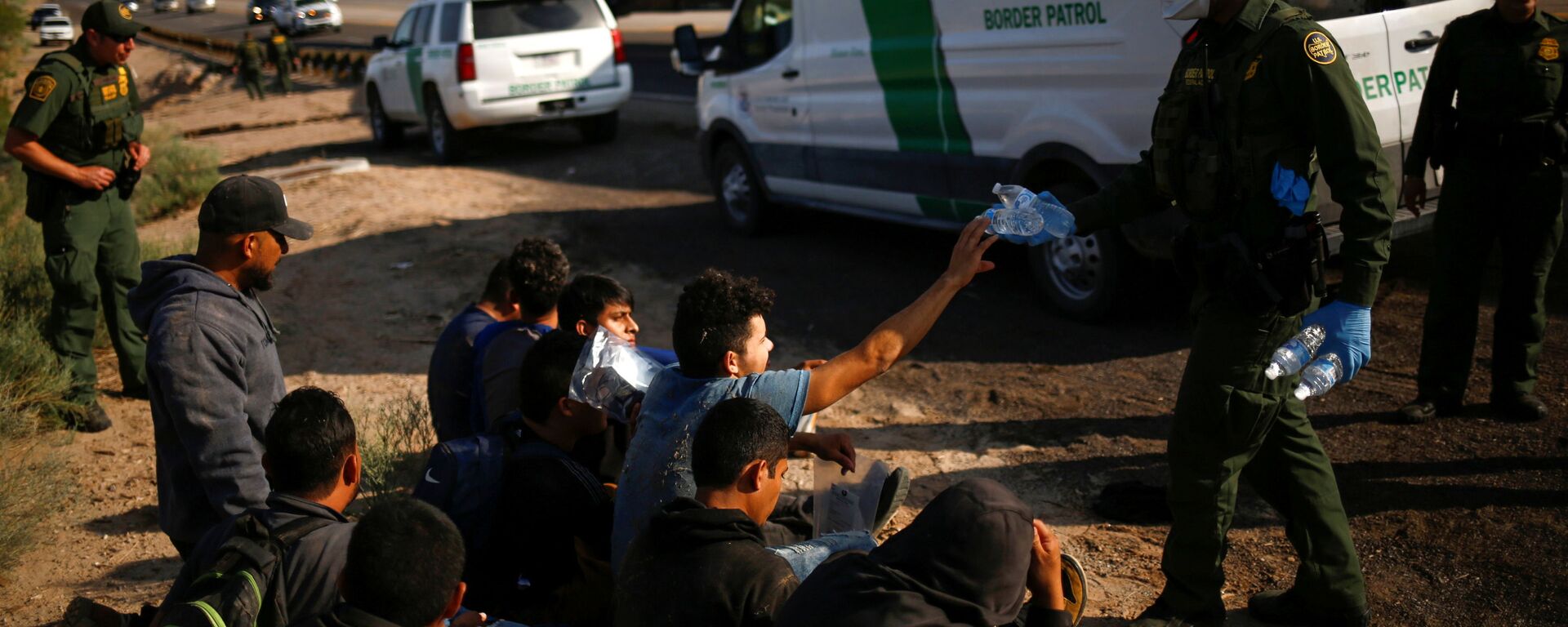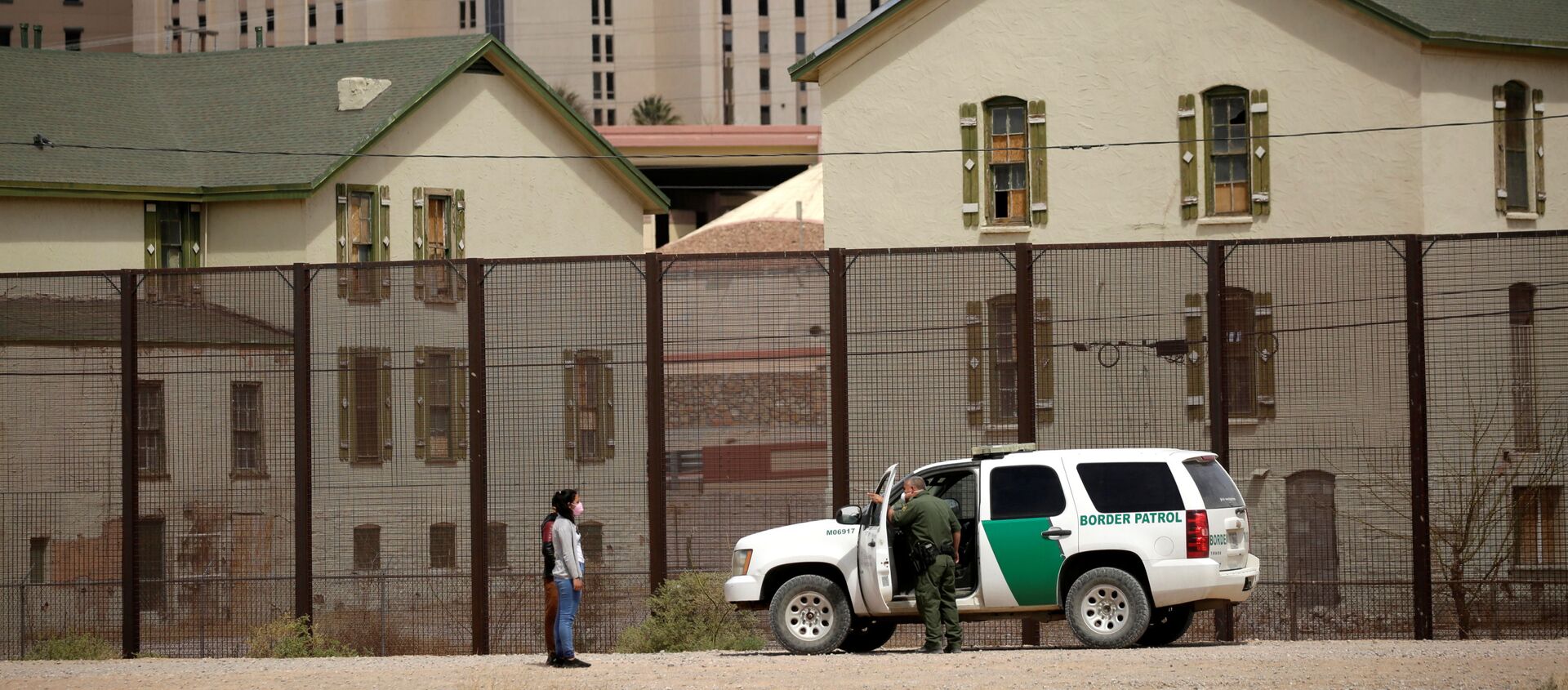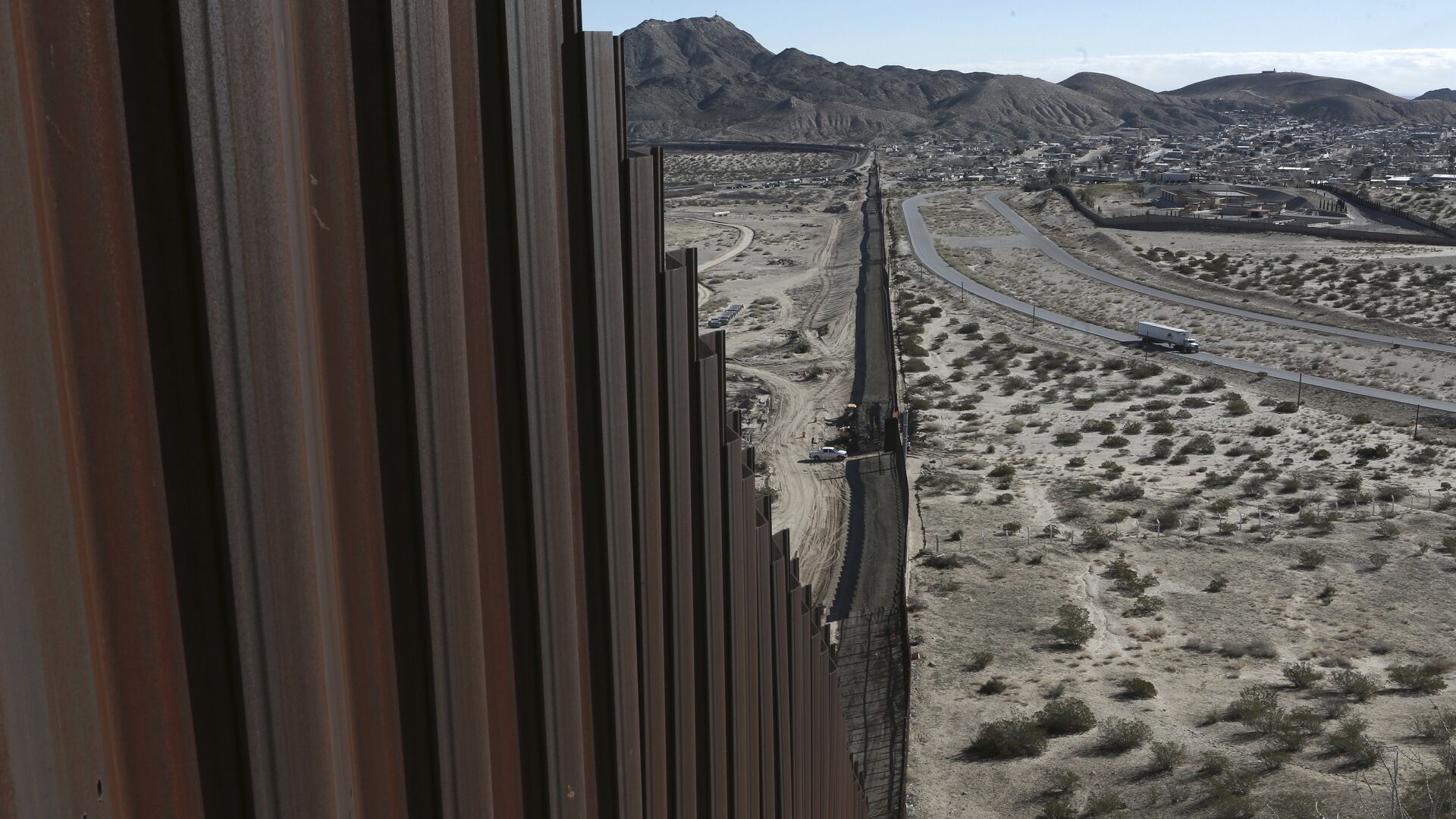https://sputnikglobe.com/20210906/border-patrol-rushes-to-patch-up-porous-us-mexico-frontier-as-building-materials-rust-report-finds-1083806926.html
Border Patrol Rushes to Patch Up Porous US-Mexico Frontier as Building Materials Rust, Report Finds
Border Patrol Rushes to Patch Up Porous US-Mexico Frontier as Building Materials Rust, Report Finds
Sputnik International
The Biden administration found itself facing a major migrant crisis on the US’s southern border with Mexico almost immediately after coming into office in... 06.09.2021, Sputnik International
2021-09-06T10:58+0000
2021-09-06T10:58+0000
2021-09-06T10:58+0000
us
world
newsfeed
https://cdn1.img.sputnikglobe.com/img/105212/09/1052120977_0:178:5628:3344_1920x0_80_0_0_f80b78f220c16a0b311e92a40fcff706.jpg
A group of Border Patrol agents in New Mexico has independently constructed a makeshift barrier to plug a 20-foot gap in the US-Mexico frontier wall after federal contractors stopped work when the Biden administration cut funding.The gap, situated at Border Monument Three, one of nearly 300 original frontier markers built after the Mexican-American War of 1848, in the aftermath of which the United States annexed wide swathes of Mexican territory stretching from New Mexico to California, is feared to have allowed thousands of migrants, human smugglers and drug runners to make their way into the US.Agents told the newspaper that thousands of tonnes of steel and other building materials have been left rusting and gathering dust since feds pulled the plug on funding for wall construction.Stopping the construction of former President Donald Trump’s border wall was one of the very first executive actions taken by President Joe Biden when he stepped into office in January, with the new administration redirecting the estimated $2.2 billion in border wall funds to the military budget.“We have some agents who are good welders, and they put it all together,” Barragan said. “Any infrastructure is helpful to us. These are just some of the challenges we face every day,” he added.The makeshift construction isn’t quite as tall as the 30-foot high standardized border wall that was being built by federal contractors, and its girder construction layout and holes in fencing could make it easier to cross. Still, agents are adamant that a border frontier makes their job both easier and safer.Gloria Ghavez, chief agent of Border Patrol forces in the El Paso Sector, praised the Trump wall, telling the Post that it “enhances [her] officers’ safety…delays entry and allows the agent to have the advantage.”The Trump administration managed to build about 725 km of border wall along the US-Mexico frontier, which stretches some 3,145 km from the Pacific Ocean in the west to the Gulf of Mexico in the east, before funding was pulled.US border services have observed a skyrocketing rate of encounters with potential migrants into the United States in the wake of the Biden administration’s moves in January to soften immigration policies. Agents in the El Paso Sector alone have reported the detention of over 155,000 people, nearly triple the 54,396 detained in fiscal year 2020, so far this year (the fiscal year runs from October 1 through September 30).In all, over 212,000 potential migrants were encountered by Border Patrol in July, up from 188,000 in June and 172,000 in May. Authorities estimate that total encounters are on track to reaching highs not seen since the year 2000, when some 1.7 million alien encounters were reported. As of July, over 1.4 million migrant encounters have been recorded.Authorities in states bordering Mexico have sought to walk back some of federal policies related to immigration amid the crisis. Last month, the Supreme Court backed a Texas judge’s ruling ordering federal authorities to reinstate the Remain in Mexico programme, which requires asylum applicants to wait for a decision on their application outside the United States.The border wall and Remain in Mexico programme were just two of nearly a dozen immigration-related policies ended by Biden after he stepped into office. In a flurry of executive decisions, the president vowed to end “harsh and extreme immigration enforcement,” to “restore and expand” the US asylum system, and hinted at offering a “path to citizenship” for the estimated 11 million illegal immigrants already living in the US.Biden tasked Kamala Harris to oversee the immigration crisis, with the vice president traveling to Guatemala and Mexico in June to try to figure out the crisis’s “root causes” and to discourage migrants from attempting to make the perilous journey. “I want to be clear to folks in the region who are thinking about making that dangerous trek to the United States-Mexico border: Do not come. Do not come,” she urged during her trip. Mexican President Andres Manuel Lopez Obrador and Guatemalan President Alejandro Giammattei accused the Biden administration of fueling the migration crisis via its policies and “lukewarm” rhetoric on illegal immigration.Former President Trump has repeatedly slammed his successor’s decision to end his hardline immigration policies, accusing him of “destroying our country.”
https://sputnikglobe.com/20210813/leaked-audio-dhs-sec-warns-us-may-lose-southern-border-crisis-amid-influx-of-migrant-encounters-1083600173.html
https://sputnikglobe.com/20210824/us-supreme-court-rules-biden-admin-must-reinstate-remain-in-mexico-immigration-policy-1083704975.html
Sputnik International
feedback@sputniknews.com
+74956456601
MIA „Rossiya Segodnya“
2021
News
en_EN
Sputnik International
feedback@sputniknews.com
+74956456601
MIA „Rossiya Segodnya“
Sputnik International
feedback@sputniknews.com
+74956456601
MIA „Rossiya Segodnya“
us, newsfeed
Border Patrol Rushes to Patch Up Porous US-Mexico Frontier as Building Materials Rust, Report Finds
The Biden administration found itself facing a major migrant crisis on the US’s southern border with Mexico almost immediately after coming into office in January, with the calamity starting after President Biden began signing a series of executive orders reversing his predecessor’s hardline immigration policies.
A group of Border Patrol agents in New Mexico has independently constructed a makeshift barrier to plug a 20-foot gap in the US-Mexico frontier wall after federal contractors stopped work when the Biden administration cut funding.
The gap, situated at Border Monument Three, one of nearly 300 original frontier markers built after the Mexican-American War of 1848, in the aftermath of which the United States annexed wide swathes of Mexican territory stretching from New Mexico to California, is feared to have allowed thousands of migrants, human smugglers and drug runners to make their way into the US.
“The contractors just stopped,” El Paso Sector Border Patrol agent Richard Barragan complained, speaking to the New York Post about the gap, and the aftermath of Biden’s decision in January to terminate wall funding.
Agents told the newspaper that thousands of tonnes of steel and other building materials have been left rusting and gathering dust since feds pulled the plug on funding for wall construction.

13 August 2021, 20:02 GMT
Stopping the construction of former President Donald Trump’s border wall was one of the very first executive actions taken by President Joe Biden when he stepped into office in January, with the new administration redirecting the estimated
$2.2 billion in border wall funds to the military budget.
Deciding to take action independently, the New Mexico Border Patrol agents decided to plug the gap at Border Monument Three themselves, as best they could, using leftover steel girders, metal fencing, old tires and other trash.
“We have some agents who are good welders, and they put it all together,” Barragan said. “Any infrastructure is helpful to us. These are just some of the challenges we face every day,” he added.
The makeshift construction isn’t quite as tall as the 30-foot high standardized border wall that was being built by federal contractors, and its girder construction layout and holes in fencing could make it easier to cross. Still, agents are adamant that a border frontier makes their job both easier and safer.
Gloria Ghavez, chief agent of Border Patrol forces in the El Paso Sector, praised the Trump wall, telling the Post that it “enhances [her] officers’ safety…delays entry and allows the agent to have the advantage.”
The Trump administration managed to build about 725 km of border wall along the US-Mexico frontier, which stretches some 3,145 km from the Pacific Ocean in the west to the Gulf of Mexico in the east, before funding was pulled.
US border services have observed a skyrocketing rate of encounters with potential migrants into the United States in the wake of the Biden administration’s moves in January to soften immigration policies. Agents in the El Paso Sector alone have reported the detention of over 155,000 people, nearly triple the 54,396 detained in fiscal year 2020, so far this year (the fiscal year runs from October 1 through September 30).
In all,
over 212,000 potential migrants were encountered by Border Patrol in July, up from 188,000 in June and 172,000 in May. Authorities estimate that total encounters are on track to reaching highs not seen since the year 2000, when some 1.7 million alien encounters were reported. As of July, over 1.4 million migrant encounters have been recorded.

24 August 2021, 23:46 GMT
Authorities in states bordering Mexico have sought to walk back some of federal policies related to immigration amid the crisis. Last month, the Supreme Court
backed a Texas judge’s ruling ordering federal authorities to reinstate the Remain in Mexico programme, which requires asylum applicants to wait for a decision on their application outside the United States.
The border wall and Remain in Mexico programme were just two of
nearly a dozen immigration-related policies ended by Biden after he stepped into office. In a flurry of executive decisions, the president vowed to end “harsh and extreme immigration enforcement,” to “restore and expand” the US asylum system, and hinted at offering a “path to citizenship” for the estimated 11 million illegal immigrants already living in the US.
Biden tasked Kamala Harris to oversee the immigration crisis, with the vice president traveling to Guatemala and Mexico in June to try to figure out the crisis’s “root causes” and to discourage migrants from attempting to make the perilous journey. “I want to be clear to folks in the region who are thinking about making that dangerous trek to the United States-Mexico border: Do not come. Do not come,” she urged during her trip. Mexican President Andres Manuel Lopez Obrador and Guatemalan President Alejandro Giammattei
accused the Biden administration of
fueling the migration crisis via its policies and “lukewarm” rhetoric on illegal immigration.
Former President Trump has repeatedly slammed his successor’s decision to end his hardline immigration policies, accusing him of “destroying our country.”




